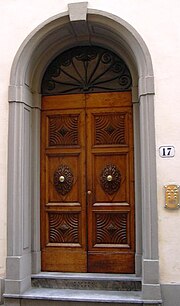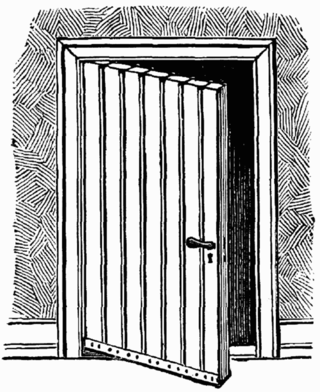
A door is a hinged or otherwise movable barrier that allows ingress (entry) into and egress (exit) from an enclosure. The created opening in the wall is a doorway or portal. A door's essential and primary purpose is to provide security by controlling access to the doorway (portal). Conventionally, it is a panel that fits into the doorway of a building, room, or vehicle. Doors are generally made of a material suited to the door's task. They are commonly attached by hinges, but can move by other means, such as slides or counterbalancing.

A hinge is a mechanical bearing that connects two solid objects, typically allowing only a limited angle of rotation between them. Two objects connected by an ideal hinge rotate relative to each other about a fixed axis of rotation, with all other translations or rotations prevented; thus a hinge has one degree of freedom. Hinges may be made of flexible material or moving components. In biology, many joints function as hinges, such as the elbow joint.
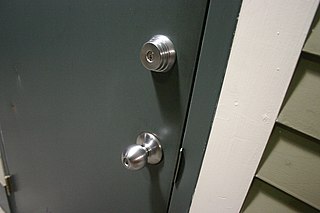
A deadbolt or deadlock is a type of lock morticed into a wooden door. Then, using a key from either side of the door, a bolt is thrown into the door frame, thus securing the door. It is distinct from a spring bolt lock because a deadbolt can only be opened by a key or handle. The more common spring bolt lock uses a spring to hold the bolt in place, allowing retraction by applying force to the bolt itself. A deadbolt can therefore make a door more resistant to entry without the correct key, as well as make the door more resistant to forced entry. A deadbolt is often used to complement a spring-bolt lock on an entry door to a building.
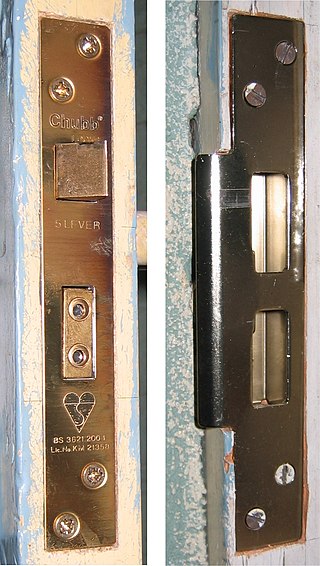
A mortise lock is a lock that requires a pocket—the mortise—to be cut into the edge of the door or piece of furniture into which the lock is to be fitted. In most parts of the world, mortise locks are found on older buildings constructed before the advent of bored cylindrical locks, but they have recently become more common in commercial and upmarket residential construction in the United States. The design is widely used in domestic properties of all vintages in Europe.

A crash bar is a type of door opening mechanism which allows users to open a door by pushing a bar. While originally conceived as a way to prevent crowd crushing in an emergency, crash bars are now used as the primary door opening mechanism in many commercial buildings.

A door handle or doorknob is a handle used to open or close a door. Door handles can be found on all types of doors including exterior doors of residential and commercial buildings, internal doors, cupboard doors and vehicle doors. There are many designs of door handle, depending on the appropriate use. A large number of handles, particularly for commercial and residential doors, incorporate latching or locking mechanisms or are manufactured to fit to standardised door locking or latching mechanisms.
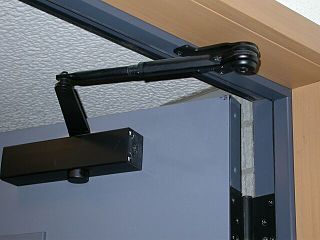
A door closer is a mechanical device that regulates the speed and action of a door’s swing. Manual closers store the force used to open the door in some type of spring and reuse it to close the door. Automatic types use electricity to regulate door swing behavior.

A latch or catch is a type of mechanical fastener that joins two objects or surfaces while allowing for their regular separation. A latch typically engages another piece of hardware on the other mounting surface. Depending upon the type and design of the latch, this engaged bit of hardware may be known as a keeper or strike.

An electronic lock is a locking device which operates by means of electric current. Electric locks are sometimes stand-alone with an electronic control assembly mounted directly to the lock. Electric locks may be connected to an access control system, the advantages of which include: key control, where keys can be added and removed without re-keying the lock cylinder; fine access control, where time and place are factors; and transaction logging, where activity is recorded. Electronic locks can also be remotely monitored and controlled, both to lock and to unlock.

An electric strike is an access control device used for door frames. It replaces the fixed strike faceplate often used with a latch. Like a fixed strike plate, it normally presents a ramped or beveled surface to the locking latch allowing the door to close and latch just like a fixed strike would. However, an electric strike's ramped surface can, upon command, pivot out of the way when the lock on the door is in the locked position and the door is opened, allowing a user to pull/push the door to open it without operating the mechanical lock or using a mechanical key. After the door is opened past the keeper, the keeper returns to its standard position and re-locks when power is removed or applied, depending upon the strike's configuration.

The term door security or door security gate may refer to any of a range of measures used to strengthen doors against door breaching, ram-raiding and lock picking, and prevent crimes such as burglary and home invasions. Door security is used in commercial and government buildings, as well as in residential settings.
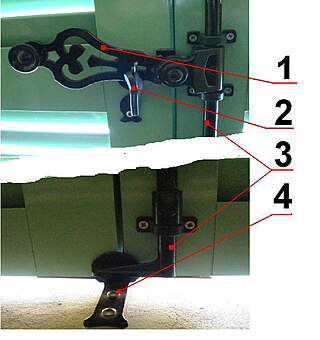
An espagnolette is a locking device, normally mounted on the vertical frame of a French door or casement window. A handle or knob is connected to a metal rod mounted to the surface of the frame, about a metre above the floor. Operating the handle rotates the rod, which has hooks at each end that fit into sockets at the head and sill of the opening. This type of lock is often used on semi-trailer trucks to fasten the rear doors. It can be identified by the use of a round bar, instead of a half-round bar used on a crémone bolt.

Three-point locking, or a multipoint lock, is a locking system installed in cabinet or locker doors to enable more secure locking. Whereas in single-point locking, the door on a cabinet locks only at the point where the key is turned, halfway up the edge of the door, three-point locking enables the top and bottom of the door to be simultaneously secured. This is accomplished by attaching two long steel rods to the lock on the inside of the door, which extend vertically upwards and downwards: when the lock is turned, the rotary movement of the latch on the inside of the door translates to vertical movement in these rods, with the result that the upper rod moves upwards by an inch or so, and the lower rod moves downwards similarly. This causes the ends of the rods to move through small holes in the flanges at the top and bottom of the door, resulting from the metal of the door being turned inwards, and the rods then move a short distance into holes in the metal surrounding the door. This effectively immobilizes the top and bottom of the door, and greatly increases the security of the door-locking compared to a door with only single-point locking.

Door breaching is a process used by military, police, or emergency services to force open closed or locked doors. A wide range of methods are available depending on the door's opening direction, construction materials, etc., and one or more of these methods may be used in any given situation. In the United States, residential doors typically open inward while commercial building doors usually open outward. Some breaching methods require specialized equipment and can be categorized as one of the following: mechanical breaching, ballistic breaching, hydraulic breaching, explosive breaching, or thermal breaching.

Window shutter hardware, usually made of iron, are hinges and latches that attach to the shutter and a window frame. The hinges hold the shutter to the structure and allow the shutter to open and close over the window. The latches secure the shutter in the closed position. Tie-back hardware can be used to hold the shutter in the open position.

A drawer pull is a handle to pull a drawer out of a chest of drawers, cabinet or other furniture piece.
Builders' hardware or just builders hardware is a group of metal hardware specifically used for protection, decoration, and convenience in buildings. Building products do not make any part of a building, rather they support them and make them work. It usually supports fixtures like windows, doors, and cabinets. Common examples include door handles, door hinges, deadbolts, latches, numerals, letter plates, switch plates, and door knockers.

A lockset is the hardware and components that make up the locking or latching mechanism that can usually be found on a door or other hinged object but can also include sliding doors and dividers. The components of a lockset can include the door handles, latch bolt, dead bolt, face plate, strike plate, escutcheon, thumbturn, push button, turn button, and other trim. The lockset and associated hardware typically defines a door's function and how a user could access the two adjacent spaces defined by the opening associated with the lockset.
This is a glossary of locksmithing terms.
